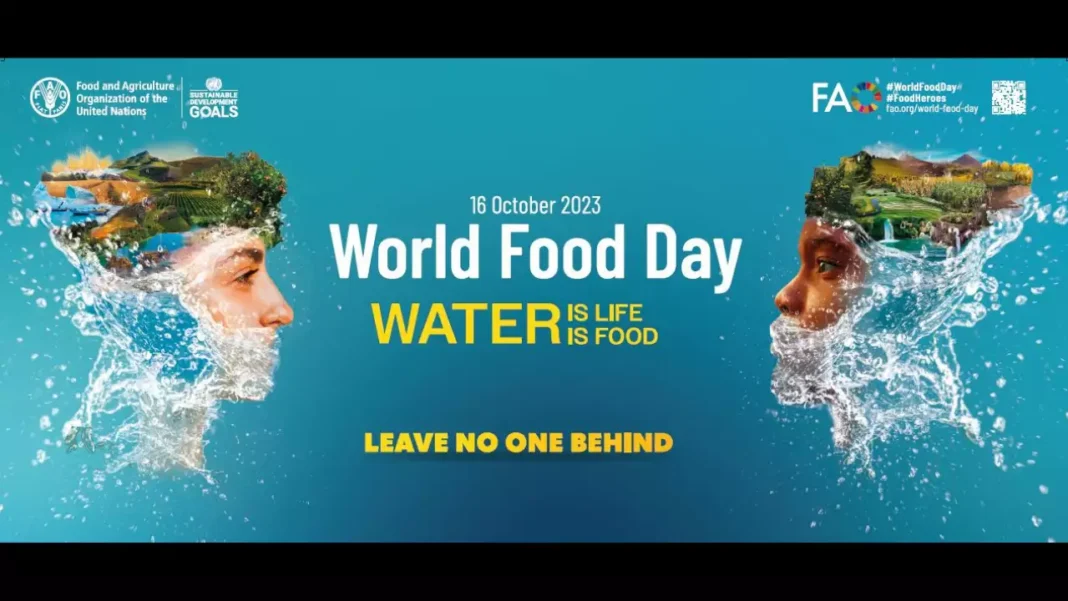World Food Day, observed globally every year on October 16, commemorates the establishment of the United Nations Food and Agriculture Organization (FAO) in 1945.
This important day garners extensive participation from numerous organizations dedicated to addressing hunger and food security issues.
The World Food Programme (WFP), the World Health Organization, and the International Fund for Agricultural Development are among these organizations.
In 2020, the WFP was awarded the Nobel Peace Prize for its remarkable efforts in combatting hunger, fostering peace in conflict zones, and leading the charge to eliminate the use of hunger as a weapon in times of war and strife.
In 2023, World Food Day focuses on the theme of “water – ‘water is life, water is food. Leave no one behind,” with the goal of raising awareness about water scarcity and the interconnectedness of food and water.
Water, a vital life-sustaining element, is abundant on our planet, constituting over 50% of the human body’s composition and covering approximately 71% of the Earth’s surface.
Also read: World Water Week 2022 commences
However, a mere 2.5% of the world’s water qualifies as freshwater, suitable for drinking, agriculture, and most industrial applications.
Water plays a pivotal role, serving as a driving force for human societies, economies, and the natural environment, and it stands as the fundamental underpinning of our food production.
Agriculture alone claims a significant 72% of global freshwater withdrawals. Yet, like all natural resources, freshwater is finite and not inexhaustible.
The world’s relentless population growth, urbanization, economic advancement, and the impacts of climate change are placing increasing stress on our water resources.
At the same time, freshwater availability per capita has dwindled by 20% in recent decades, while water quality and accessibility have suffered rapid deterioration.
This decline is attributed to decades of poor resource management, excessive groundwater extraction, pollution, and the effects of climate change. This alarming trend places us at risk of reaching a critical juncture with this invaluable resource.
The UN Secretary-General António Guterres message for World Food Day in 2023 highlights a global food crisis where hunger and malnutrition are on the rise.
Approximately 780 million people are going hungry, and funding for humanitarian aid is insufficient. The root causes of this crisis include conflicts, climate extremes, inequality, and economic instability.
The message emphasizes the importance of sustainable, equitable food systems, increasing investments in resilient agriculture aligned with climate action, and utilizing science and technology to improve food systems.
The theme for this year’s World Food Day is water, emphasizing its role in food production and the need for sustainable water management to end hunger and achieve the Sustainable Development Goals.
The message calls for global collaboration to prioritize feeding the hungry and addressing this crisis, ultimately working towards a world with zero hunger.
Currently, approximately 2.4 billion individuals reside in regions grappling with water scarcity, including vulnerable groups such as women, Indigenous Peoples, migrants, and refugees.
These communities are already encountering difficulties in meeting their daily water needs, and competition for this precious resource is escalating, making water scarcity a growing source of conflict.
Moreover, about 600 million people, whose livelihoods are intricately linked to aquatic food systems, are enduring the adverse consequences of pollution, the degradation of ecosystems, unsustainable practices, and the far-reaching impacts of climate change.
Over the years, World Food Day has embraced various themes to focus on specific challenges.
In 2014, the theme centered on the significance of family farming, emphasizing the role of these small-scale operations in “feeding the world” while promoting environmental stewardship with the slogan “caring for the earth.”
The following year, in 2015, the theme revolved around “Social Protection and Agriculture,” with a primary goal of breaking the cycle of rural poverty.
In 2016, the theme was centered on climate change, underlining the importance of adapting food and agriculture practices to this evolving environmental reality, echoing similar themes from 2008, 2002, and 1989.
Notably, the theme for 2020 was “Grow, nourish, sustain. Together. Our actions are our future,” highlighting the collective responsibility in ensuring a sustainable and food-secure world.






